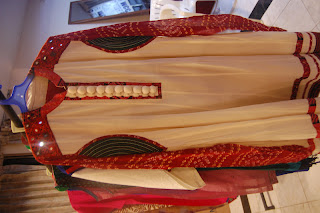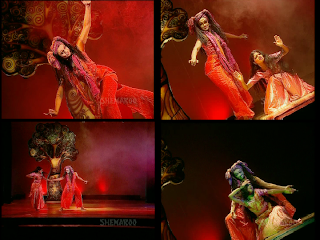 My gaze rested on the first table laden with clay jewellery of various shapes. Manjusha and Satish bent over their ethereally earthy treasures with almost parental affection and care. The wares were indeed unique in design, shape and texture.Ear-drops, pendants and neck-strings were more likely to have appeared from Eden than from an Accessory store. Each of them spoke of a rare connection with nature and was thus a testimony to the ultimate creation.
My gaze rested on the first table laden with clay jewellery of various shapes. Manjusha and Satish bent over their ethereally earthy treasures with almost parental affection and care. The wares were indeed unique in design, shape and texture.Ear-drops, pendants and neck-strings were more likely to have appeared from Eden than from an Accessory store. Each of them spoke of a rare connection with nature and was thus a testimony to the ultimate creation. Read more on http://jewelsoutofclay.blogspot.in/
 Moving
on, one couldn't miss the fiery Radha Gomathi with Sangmitra, her
magnificent array of cloth bags. Jholas, vanity bags, mobile pouches
and drawstring money-bags spread out like a Chiaroscuro
rainbow. Sangmitra is an All- Women collective that specialises in
crafting cloth bags from tailoring waste. The whole section had a
mystical quality about it; at once deep, introspective, rebellious,
impulsive, childish, matter-of-factly and spiritual. I had heard so
much about Aparna's Radha-chechi ( who , appearance-wise was TV
artiste Sona Nair with Michael Jackson's hairdo and personality-wise
was more intriguing than the Mona Lisa) and was prepared for her
compelling aura.
Moving
on, one couldn't miss the fiery Radha Gomathi with Sangmitra, her
magnificent array of cloth bags. Jholas, vanity bags, mobile pouches
and drawstring money-bags spread out like a Chiaroscuro
rainbow. Sangmitra is an All- Women collective that specialises in
crafting cloth bags from tailoring waste. The whole section had a
mystical quality about it; at once deep, introspective, rebellious,
impulsive, childish, matter-of-factly and spiritual. I had heard so
much about Aparna's Radha-chechi ( who , appearance-wise was TV
artiste Sona Nair with Michael Jackson's hairdo and personality-wise
was more intriguing than the Mona Lisa) and was prepared for her
compelling aura.  All the same, what struck a chord within me was
how, she had a story for each of her creation. She had this uncanny
ability to size up a person in nano-seconds and fish out just the
right bag for him/her alongwith providing a 2-minute account of the
bag's character, maintenance tips and value proposition. Whoever had
doubts on the Art of Marketing should take a few leaves out of
Radha-chechi's book. Move over, Kotler!
All the same, what struck a chord within me was
how, she had a story for each of her creation. She had this uncanny
ability to size up a person in nano-seconds and fish out just the
right bag for him/her alongwith providing a 2-minute account of the
bag's character, maintenance tips and value proposition. Whoever had
doubts on the Art of Marketing should take a few leaves out of
Radha-chechi's book. Move over, Kotler!Read about the artist Radha on http://www.thehindu.com/life-and-style/metroplus/article2984928.ece
 Chip
of the old(?) block, little Aravind was precociousness clad in a
Fabindia shirt leapfrogging across the hall, calling out to and befriending every visitor on the premises. it was impossible to miss the adorable brat who seemed to be on s a self- appointed endearment
strategy interrupted only by Radha-chechi's call to duty: he was
mama's Accountant-boy after all!
Chip
of the old(?) block, little Aravind was precociousness clad in a
Fabindia shirt leapfrogging across the hall, calling out to and befriending every visitor on the premises. it was impossible to miss the adorable brat who seemed to be on s a self- appointed endearment
strategy interrupted only by Radha-chechi's call to duty: he was
mama's Accountant-boy after all! This picture was taken towards closing time. "Here's Scrooge!", commented his mom. What say, Aravindo?
I'm not surprised.
You can reach Karthik on 098945 10545 or prakrithi_skk@yahoo.com
 dThe Okhamandal region in Gujarat is a drought prone area. With an average annual rainfall of 8-10 inches, the region is declared a drought zone every third year. With 70% of the village population dependent on agriculture, it becomes imperative that an alternate source of livelihood be promoted to reduce the dependence on agriculture.
dThe Okhamandal region in Gujarat is a drought prone area. With an average annual rainfall of 8-10 inches, the region is declared a drought zone every third year. With 70% of the village population dependent on agriculture, it becomes imperative that an alternate source of livelihood be promoted to reduce the dependence on agriculture.Mrs. Iyer ( that's one of my names for Appu) re-appeared in a salwar-kurta and her delightful babe Ram. Vinod, Her Tower of Strength joined too. The small wonder took in every detail around him in his saucer-eyes. Seemed to have an interest in morphology as he probed, stroked, nibbled and clawed Appa's ears and nose. He in fact left no bit unexplored, tugging even at a stray nylon wire till it yielded.
You can take Aparna away from Apparels but you can never take the Apparels away from Aparna! Chanthakkaree did live up to its brain-mother's reputation in two stalls which would have been any cloheshorse's plunder. Her dazzling range of hand-picked silks and cool cottons would make any passerby gawk. Even buy. Sample this parrot green saree with a dramatic border.
 There
was also an impressive collection of Gujarati and Hyderabadi dress
materials. A few pieces had intricate embroidery in woolen thread.
I've always been fascinated by Kutch and Bandhani designs since Hum
Dil De Chuke Sanam, and it was a treat for the eyes to see them
imposed on well-tailored kurtas and suits. This one was a class apart, what with those dramatic buttons and mirrorwork. I was told that these are Kutch patterns from Gujarat. This garment reminded me of my pre-adolescent sketches of dress-patterns, many many summers back!
There
was also an impressive collection of Gujarati and Hyderabadi dress
materials. A few pieces had intricate embroidery in woolen thread.
I've always been fascinated by Kutch and Bandhani designs since Hum
Dil De Chuke Sanam, and it was a treat for the eyes to see them
imposed on well-tailored kurtas and suits. This one was a class apart, what with those dramatic buttons and mirrorwork. I was told that these are Kutch patterns from Gujarat. This garment reminded me of my pre-adolescent sketches of dress-patterns, many many summers back! To cut a long story short, suffice it to say that the stall helped me update my once- impressive knowledge of women's apparel.

Looks like Radha-chechi already has competition?!
Catch Sreedharan Master on 9961224598, 0495 2296606
 |
| Image Courtesy: in.monavie.com |
 |
| The Energy Drink! |
 |
| Dr Anaz (L) with Mr Radhakrishnan ( My 'Dupe') |
Interested? Reach Dr. Anaz on 94955 39708 or caanaz@gmail.com
I reflected on Chanthakkaree on my homeward train journey. Here was Appu -with sheer grit, passion and her indigenous networking skills- balancing what she loves to do and what she has to do ( family, housekeeping, parenting, boring social commitments...) still coming up with a fresh, classy and somewhat niche effort. I've often wondered where she derives this rare gift of surprising everybody around her with her appetite for adventure. I've known her since her final-year-at- grad- college days, through her MBA sojourn where she started exploring herself; her near-Bohemian exterior ( which made her decision to marry, something of a paradoxical volte face), and her amazing ease as a home-maker and mother. And at a time when we expected her to be nappy-happy, she surprises the world with her Odysseys in search of craft. In her own words, " ...my friends were trying to 'study' MBA, I'm living it! Chanthakkaree taught me what it's like to take risks, how to earn value for money and what customer - not consumer- behaviour is all about ( she has recently worked as a store-salesgirl for a leading Handicrafts emporium out of sheer curiosity for what it feels like). Thanks Appu, for demonstrating what it takes to be a Rebel With a Cause.
Aparna's absolutely devoted to her fantastic husband Mr Vinod Iyer ( whom I've known and befriended since my Rotary GSE days), who also has a penchant for donning various hats: Entrepreneur, Motivational Speaker, Professional Trainer, Soccer Player, Compere, loving dad and much more. Mohanlal's famous dialogue in Manichithrathazhu should best describe Mr and Mrs. Iyer " ലോകത്തിലെ ഒരു ഭര്ത്താവും ഭാര്യയും മനസ്സ് കൊണ്ട് ഇത്ര ആഴത്തില് പരസ്പരം അറിഞ്ഞു കാണില്ല." ( No other husband and wife in this world would have known each other so well....). Touch Wood.
 |
| The Vinods! |
I'd urge every student, teacher and practitioner of Management ( plus Go Green Activists, Event Managers, Entrepreneurs, Media moghuls, mothers, wives, Gen Y boys and girls .....) to read, understand and assimilate Chanthakkaree as a case of exuberance, energy and enterprise.
Go Aparna, Go!
Tailpiece:
 |
| The Deccan Chronicle ( Calicut), 20th Aug '12 |




















































































